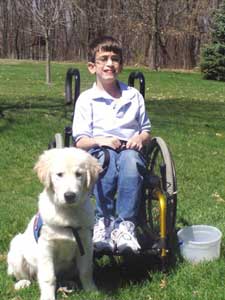
Dylan and Hero
Julie, please tell us what led to your interest in the animal behavior profession.
I adopted a fear-aggressive German shepherd that stole my heart. Unfortunately, he led a tortured life because 26 years ago no one knew what to do with aggressive animals except use a choke collar and punish the aggressive behavior. Today we treat patients like my “Rio” every day. We make their lives and their owners’ lives better. I have a deep empathy for the animals and the owners—I’ve walked in their shoes.
In 1993, my son Dylan was born 3½ months prematurely. Dylan had brain trauma which caused his cerebral palsy. I had to do something, and training a service dog to assist him became my goal. But, I had to find something besides a choke collar—I simply couldn’t see a child jerking on a choke collar. I read, I researched, and I found clicker training. Faith, Dylan’s first service dog, and I muddled through things together. Neither of us quite knew what we were doing, but both were willing to try. Faith worked with Dylan until she developed lymphosarcoma at the age of 6. I did not want to take on the responsibility of training another service dog, but Dylan, who was then 9 years old and who had had Faith at his side since he was 3, said, “Mom, it’s like losing a Mom, my best friend, and an arm all at the same time.”
Hero, Dylan’s second service dog, arrived as Faith’s health declined and the training process began again. Dylan is now 17, and Hero is in partial retirement, but both Faith and Hero helped shape my son into the man he is now.
How did your career as an animal behavior technologist begin? What led to the start of your program at a leading midwest veterinary university?
Dr. Luescher, the director of a leading midwest veterinary university's Animal Behavior Clinic, heard about the clicker training I was doing in northern Indiana, and when the position opened at a leading midwest veterinary university I was offered an interview. We are the only veterinary school with a veterinary technology program and a veterinary animal behaviorist under the same roof. We teach veterinarians and veterinary nurses how to work together to treat behavior problems. I describe myself to clients as “an animal nurse specialist to an animal psychiatrist.”
What was your reason for starting the Society of Veterinary Behavior Technicians (SVBT)?
The inspiration for starting SVBT was the goal of creating the Academy of Veterinary Behavior Technicians (AVBT). Through the AVBT, veterinary technicians can become certified as Veterinary Technician Specialists (VTS) in the field of behavior (VTS-Behavior). A veterinary technician who is a VTS-Behavior has reached a high level of expertise in the specialty of animal behavior.
Including myself, there are currently seven VTS-Behavior in the country, and three of the seven are also Karen Pryor Academy (KPA) Certified Training Partners (CTPs). Alicea Schaeffer and Debbie Martin were the first two technicians to qualify for and pass the VTS-Behavior examination. Both are former KPA students of mine, and nothing is more rewarding for me than seeing my students excel. I am very, very proud of them.
What in your personal experience helped to shape your advocacy for force- free training?
That is easy. I see the damage force training causes. I see it every day in the patients who arrive at the behavior clinic frightened, defensive, and confused (the same words describe their owners). When I begin working with the dogs, allowing them to make choices about their behavior, they blossom during the two-hour appointment. Tails begin to wag. The dogs relax and, for a little while, there is nothing for them to fear. The owners see their animals transformed in front of their eyes, and that gives them hope.The owners see their animals transformed in front of their eyes, and that gives them hope.
You’ve been clicker training for more than 15 years. How have your skills developed over the years?
I’m still developing my skills; things are always changing. I remember when I used prompts and lures (that I could never completely get rid of).
I can remember Faith putting Dylan’s shoe in the kitchen sink, or Hero opening the refrigerator during the night and eating everything, including the salsa. Obviously, stimulus control was an issue.
I remember saying, “Don’t put it on cue until the behavior is perfect!” Now I add cues quickly and have seen frustration levels drop dramatically. Now I keep records; I pay attention to changes in latency and rate of reinforcement/minute.
These days we have clicker trainers who never “did it wrong,” who never were cross-over trainers. We have dogs that know nothing but clicker training as a way to learn. Dogs learning to “match to sample” and “mimic” and other concept training—wow! The sky is the limit, and I cannot begin to predict where we will be in 10 years.
How can trainers and vets work together successfully to treat and prevent behavior issues?
A trainer can work with the veterinarian’s client to apply behavior modification techniques the veterinarian has recommended or prescribed. The trainer can also be the veterinarian’s “eyes and ears” while working with the pet owner. For example, a veterinarian may diagnose territorial aggression and ask the trainer to work with the owner to teach the dog to go to a mat, counter-condition the doorbell, and desensitize people coming in the door. It’s likely the veterinarian will also ask the trainer to fit the dog with a head collar and teach the owner how to do response substitution on walks.
My goal is to teach trainers to be able to do what I do with clients in the client’s home, and then report back to the veterinarian in a true symbiotic relationship. My goal is to teach trainers to be able to do what I do with clients in the client's home, and then report back to the veterinarian in a true symbiotic relationship. Our mutual goal is to help the pet owner and pet.
You are a veteran faculty member of Karen Pryor Academy. What role do you see for the Academy in building an interdisciplinary relationship between dog trainers and veterinarians?
There was a time when I felt that dog trainers and veterinary professionals were working against one another, almost as if there was an unspoken lack of respect across the professions. I felt that I was left with little choice but to keep my focus in the venue of veterinary medicine, but Karen Pryor changed that. She created a program that requires Certified Training Partners to be 1) respectful and good with people, 2) highly professional, 3) scientific and objective, yet empathetic, and 4) constantly seeking continuing education. Now these common denominators make it possible for veterinary professionals and dog trainers to work together with the same ultimate goal—protecting the human-animal bond.
What advice would you give trainers about building productive partnerships with veterinarians in their own communities?
Mutual respect is key, and staying within the parameters of your professional role is paramount. Always be professional, and never contradict the veterinarian to the client. Keep in mind what a compliment it is for a veterinarian to trust you with his or her client. Be scientific but empathetic.
If a trainer has only 30 seconds at a vet office, what should he/she communicate?
Drop off cookies and coupons for veterinary staff to attend your classes at discounted or free cost. After that, ask to give a lunchtime demonstration to the staff.
We are thrilled that you’ll be speaking at ClickerExpo 2011 in Chicago, Illinois, and in Newport Beach, California. Can you give us a preview of what you’ll be talking about and what you hope attendees get out of your presentation?
I am very excited about these Sessions and the hands-on Learning Lab. My goal is to introduce trainers to some of the behavior modification techniques veterinarians may ask them to use to assist their clients. I’ll be using many video segments to show attendees my role, including some that demonstrate problem-solving when things do not go as planned. During the Learning Labs we will apply the techniques demonstrated in the Session lectures.
You finished a text book for veterinary technicians recently. Can you tell us more about that?
The book should be finished in 2011 and go to press that same year. Currently there is no text for veterinary technicians (or trainers) that clarifies their roles, normal behavior, the human animal bond, training tools, communication, terminology, learning, prevention, behavior modification and/or neuro-pharmacology for veterinary para-professionals. This text will encourage all veterinary technology programs to include animal behavior in their programs. I hope it will also set the tone for future clarification in the discipline.







Post new comment